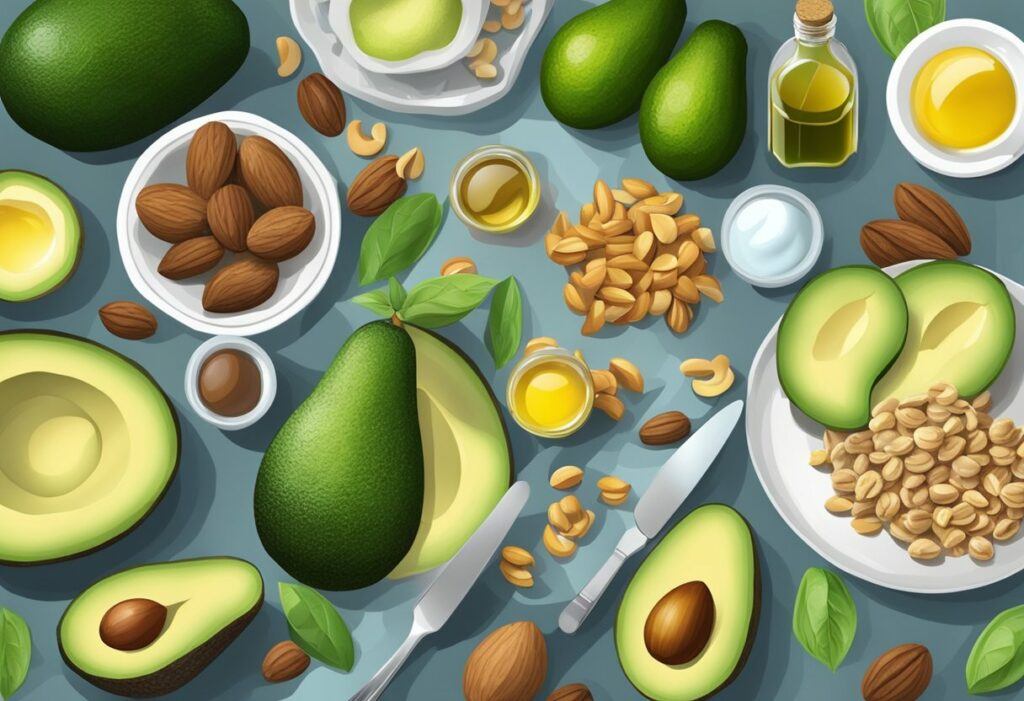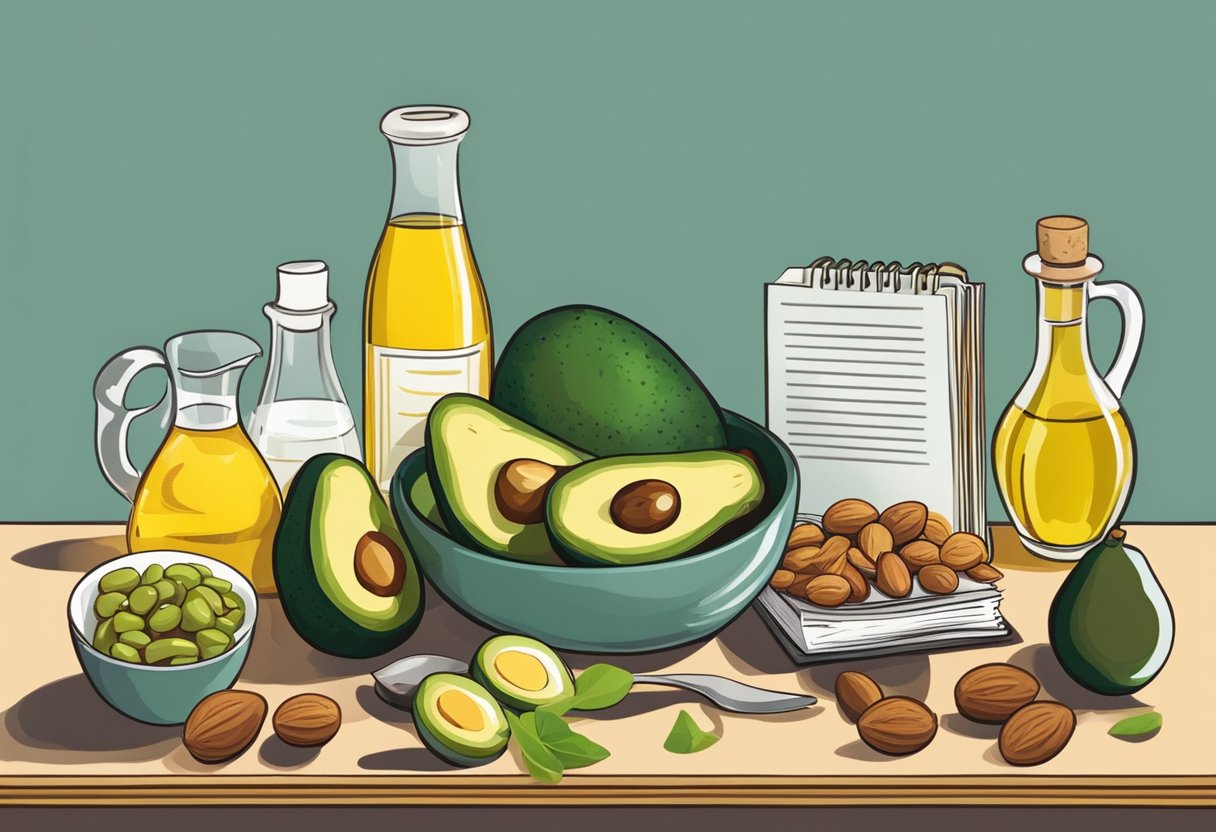Table of Contents
Fat Fast Menu: Delicious and Healthy Options for Quick Weight Loss
If you’re looking for a way to break through a weight loss plateau or kickstart ketosis, a fat fast may be the solution you need. A fat fast is a short-term, high-fat ketogenic diet that restricts calories to about 1,000 per day. It’s designed to help you lose weight quickly by forcing your body to burn fat for fuel instead of carbohydrates. So lets get started with the basics of a fat fast menu!

Planning your fat fast menu is an important part of the process. You’ll need to choose foods that are high in healthy fats and low in carbohydrates. Some good options include fatty fish, avocados, nuts and seeds, and healthy oils like coconut and olive oil. It’s also important to make sure you’re getting enough protein to support muscle growth and repair.
Key Takeaways
- A fat fast is a short-term, high-fat ketogenic diet designed to help you lose weight quickly.
- Planning your fat fast menu is essential to the success of your fat fast.
- Choose foods that are high in healthy fats, low in carbohydrates, and contain enough protein to support muscle growth and repair.
What Is a Fat Fast?
Defining Fat Fast
A fat fast is a short-term, calorie-restricted diet that involves consuming high amounts of healthy fats and very few carbohydrates and proteins. The goal of a fat fast is to induce the body to enter a state of ketosis, where it begins to burn fat for fuel instead of carbohydrates.
During a fat fast, you typically consume up to 1,200 calories per day, with 80-90% of those calories coming from healthy fats such as avocados, nuts, and coconut oil. You should also avoid consuming any carbohydrates or proteins during this time, as they can disrupt the body’s fat-burning process.
Origins and Popularity
The concept of a fat fast was first introduced by Dr. Robert Atkins, the creator of the Atkins diet, in the 1970s. However, it has gained popularity in recent years as part of the ketogenic diet, which involves consuming high amounts of healthy fats and very few carbohydrates to induce ketosis.
Fat fasting is often used as a tool to break through weight loss plateaus or to jumpstart the body’s fat-burning process. It is not recommended as a long-term diet, as it can be difficult to maintain and may not provide all the necessary nutrients for optimal health.
Overall, a fat fast can be a useful tool for those looking to kickstart their weight loss journey or break through a plateau. However, it should be used with caution and under the guidance of a healthcare professional to ensure that it is safe and effective for your individual needs.
Benefits of Fat Fasting
If you are looking to lose weight and improve your metabolic health, fat fasting may be worth considering. Here are some of the benefits you can expect from fat fasting.
Ketosis and Weight Loss
Fat fasting is a type of fasting that involves consuming a high amount of fat and very few carbs and protein. By doing so, your body enters a state of ketosis, which is when your body burns fat for fuel instead of glucose. This can lead to rapid weight loss, as your body is forced to use stored fat for energy.
In addition to weight loss, ketosis has been shown to have other health benefits, such as improved insulin sensitivity and reduced inflammation. However, it’s important to note that fat fasting should only be done for a short period of time, as prolonged ketosis can have negative effects on your health.
Improved Metabolic Health
Fat fasting has also been shown to improve metabolic health. By reducing your intake of carbs and protein, you can lower your insulin levels and improve insulin sensitivity. This can lead to a reduced risk of type 2 diabetes and other metabolic disorders.
In addition, fat fasting has been shown to reduce inflammation, which is a key contributor to many chronic diseases. By reducing inflammation, you can improve your overall health and reduce your risk of developing conditions such as heart disease, cancer, and Alzheimer’s disease.
Overall, fat fasting can be a powerful tool for improving your health and losing weight. However, it’s important to consult with a healthcare professional before starting any new diet or fasting regimen, as it may not be appropriate for everyone.
Planning Your Fat Fast Menu

When planning your fat fast menu, it’s important to consider the macronutrient ratios and meal timing and frequency. These factors play a crucial role in the effectiveness of your fat fast.
Macronutrient Ratios
For a successful fat fast, you’ll want to ensure your macronutrient ratios are in line with the recommended guidelines. Typically, a fat fast involves consuming approximately 80-90% of your daily calories from healthy fats, 5-15% from protein, and minimal carbohydrates. This can help induce ketosis and promote fat burning.
Meal Timing and Frequency
During a fat fast, meal timing and frequency can vary based on personal preference. Some people opt for 4-5 small meals a day, each around 200-250 calories, while others may prefer 1-2 regular meals. It’s essential to find a meal schedule that works best for you and aligns with your lifestyle.
Remember, consulting with a healthcare professional or a nutritionist before starting a fat fast is advisable to ensure it aligns with your individual health needs and goals.
Sample Fat Fast Recipes
If you’re looking for some delicious and easy-to-make fat fast recipes, look no further! Here are some ideas to get you started.
Breakfast Options
For breakfast, you might try making a simple omelet with cheese, spinach, and bacon. Or, if you’re in the mood for something sweet, whip up a batch of keto pancakes made with almond flour and topped with butter and sugar-free syrup. Another tasty option is to make a breakfast sandwich using a low-carb wrap, eggs, bacon, and avocado.
Lunch Ideas
For lunch, you could make a salad with mixed greens, avocado, and grilled chicken or shrimp. Another option is to make a wrap using a low-carb tortilla, deli meat, cheese, and veggies. If you’re looking for something warm and comforting, try making a bowl of cauliflower soup with heavy cream and cheddar cheese.
Dinner Selections
For dinner, you might try making a stir-fry with veggies, chicken, and coconut oil. Or, if you’re in the mood for something hearty, make a casserole with ground beef, cheese, and cauliflower rice. Another option is to make a pizza using a low-carb crust, tomato sauce, cheese, and your favorite toppings.
Remember, the key to a successful fat fast is to focus on healthy fats and keep your carb intake low. By incorporating these delicious recipes into your meal plan, you’ll be well on your way to achieving your weight loss goals.
Tips for a Successful Fat Fast

If you’re planning to try a fat fast, there are a few things you can do to make it a success. Here are some tips to help you along the way:
Staying Hydrated
During a fat fast, it’s important to stay hydrated. Drinking plenty of water can help flush out toxins and keep you feeling full. You should aim to drink at least 8 cups of water per day. You can also drink herbal tea, black coffee, or other zero-calorie beverages to help curb your appetite.
Managing Hunger
Hunger pangs can be a challenge during a fat fast. To help manage your hunger, try eating small, frequent meals throughout the day. You can also try snacking on high-fat foods like nuts, cheese, and avocado. These foods can help keep you feeling full and satisfied.
Here are some other tips to help manage hunger during a fat fast:
- Eat slowly: Take your time when eating and savor each bite. This can help you feel more satisfied and prevent overeating.
- Plan your meals: Plan out your meals ahead of time so you’re not caught off guard when hunger strikes.
- Get enough sleep: Lack of sleep can increase hunger hormones, making it harder to stick to your fat fast. Aim for at least 7-8 hours of sleep per night.
By following these tips, you can increase your chances of success during a fat fast. Remember, a fat fast should only be done for a short period of time and under the guidance of a healthcare professional.
Potential Risks and Considerations
Fat fasting has been shown to have several potential benefits, including weight loss, improved insulin sensitivity, and reduced inflammation. However, there are also some possible risks and considerations that you should be aware of before starting a fat fast.
Who Should Avoid Fat Fasting
Fat fasting may not be suitable for everyone. If you are suffering from any disease and taking medications for it, please consult your doctor, who can help you determine if a fat fast is a good option. Pregnant or breastfeeding women should also avoid fat fasting since it may not provide enough nutrients for the baby.
Possible Side Effects
While fat fasting can be an effective way to lose weight, it can also have some possible side effects. Some people may experience fatigue, weakness, dizziness, or headaches during a fat fast. Others may experience constipation or diarrhea due to changes in their diet.
Another possible side effect of fat fasting is an increase in cholesterol levels and heart disease risk. It is important to monitor your cholesterol levels regularly if you are on a fat fast and consult with your doctor if you have any concerns.
In addition, it is important to note that fat fasting is not a long-term solution for weight loss. It should only be used for short periods of time and should be followed by a healthy, balanced diet to maintain weight loss and overall health.
Supplements and Fat Fast
When following a fat fast, it’s essential to make sure you’re getting all the necessary nutrients. While the fat fast is a short-term diet, it’s still important to maintain a healthy balance of electrolytes, vitamins, and minerals.
Electrolytes
Electrolytes are essential minerals in your body that help regulate fluid balance, nerve function, and muscle contractions. When you’re on a fat fast, your body may lose electrolytes due to a decrease in water weight. To maintain proper electrolyte levels, you can supplement with sodium, potassium, and magnesium.
- Sodium: Salt your food to taste. You can also drink bone broth or pickle juice to increase sodium intake.
- Potassium: Avocado and spinach are good sources of potassium. You can also supplement with potassium chloride.
- Magnesium: Almonds and spinach are good sources of magnesium. You can also supplement with magnesium citrate.
Vitamins and Minerals
While the fat fast is high in fat, it’s important to make sure you’re still getting enough vitamins and minerals. Here are some key nutrients to focus on:
- Vitamin D: Fatty fish like salmon and tuna are good sources of vitamin D. You can also supplement with vitamin D3.
- Calcium: Cheese and leafy greens like kale and collard greens are good sources of calcium.
- Iron: Red meat and spinach are good sources of iron.
- Zinc: Oysters and beef are good sources of zinc.
By supplementing with electrolytes and focusing on key vitamins and minerals, you can ensure that your body is getting the nutrients it needs while on a fat fast.
Post-Fat Fast Transition
Congratulations on completing your fat fast! Now, it’s time to transition back to your regular diet. Here are a few tips to help you reintroduce foods and maintain your results.
Reintroducing Foods
During the fat fast, you were consuming a limited number of foods, so it’s important to reintroduce foods gradually to avoid digestive issues. Start by adding low-carb vegetables, such as spinach, broccoli, and cauliflower, to your meals. Then, add small amounts of protein, such as chicken, fish, and eggs. Finally, add healthy fats, such as avocado, olive oil, and nuts.
It’s important to pay attention to your body’s response to each food you reintroduce. If you experience any digestive discomfort, such as bloating or gas, you may need to eliminate that food from your diet or reduce your portion size.
Maintaining Results
The fat fast is a short-term strategy to kickstart weight loss, but it’s important to maintain your results over the long-term. Here are a few tips to help you do that:
- Incorporate healthy fats into your meals, such as avocado, olive oil, and nuts.
- Choose lean protein sources, such as chicken, fish, and turkey.
- Eat plenty of low-carb vegetables, such as spinach, broccoli, and cauliflower.
- Avoid processed foods and sugar.
- Stay hydrated by drinking plenty of water throughout the day.
- Exercise regularly to maintain muscle mass and burn calories.
By following these tips, you can maintain your results and continue to lose weight over the long-term. Remember, the key to success is consistency and making healthy choices every day.
Frequently Asked Questions
What foods are typically included in a fat fast menu?
A fat fast is a type of fasting where you consume mostly fat and very little protein and nearly zero carbs. Foods that are typically included in a fat fast include high-fat foods like butter, coconut oil, avocado, nuts, and seeds. Animal-based fats like fatty fish, chicken thighs, and beef are also included in the diet.
What might one expect in terms of weight loss after a 3-day fat fast?
The amount of weight loss varies from person to person. However, it is common to lose a few pounds during a 3-day fat fast. Keep in mind that this weight loss is mostly water weight and not fat loss.
Can you share a sample fat fast menu for a week-long fat fast?
Sure, here’s a sample menu for a week-long fat fast:
Day 1
- Breakfast: Bulletproof coffee
- Lunch: Avocado and macadamia nuts
- Dinner: Grilled salmon with butter and asparagus
Day 2
- Breakfast: Chia seed pudding with coconut milk
- Lunch: Beef jerky and olives
- Dinner: Baked chicken thighs with butter and green beans
Day 3
- Breakfast: Bulletproof coffee
- Lunch: Hard-boiled eggs and almonds
- Dinner: Grilled steak with butter and broccoli
Day 4
- Breakfast: Coconut milk smoothie with macadamia nuts
- Lunch: Tuna salad with avocado
- Dinner: Baked salmon with butter and spinach
Day 5
- Breakfast: Bulletproof coffee
- Lunch: Beef jerky and olives
- Dinner: Grilled chicken thighs with butter and asparagus
Day 6
- Breakfast: Chia seed pudding with coconut milk
- Lunch: Avocado and macadamia nuts
- Dinner: Baked salmon with butter and green beans
Day 7
- Breakfast: Bulletproof coffee
- Lunch: Hard-boiled eggs and almonds
- Dinner: Grilled steak with butter and broccoli
Is a fat fast effective for weight loss, and how does it work?
A fat fast can be effective for weight loss in the short term. It works by restricting your calorie intake and forcing your body to burn fat for fuel instead of carbs. However, it is not a sustainable long-term weight loss solution.
What are the potential benefits of following a fat fast menu?
The potential benefits of doing a fat fast include short-term weight loss, improved insulin sensitivity, and increased satiety. It may also help break through weight loss plateaus.
How does a vegetarian fat fast differ from the standard approach?
A vegetarian fat fast differs from the standard approach in that it excludes animal-based fats like fatty fish, chicken thighs, and beef. Instead, it includes high-fat plant-based foods like avocado, nuts, seeds, and coconut oil.

